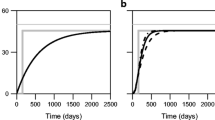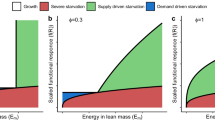Summary
-
1.
A formula is derived, in the setting of a distributed-parameter population model, for the net production of a population structured in weight, in the case of continuous reproduction.
-
2.
The expression is consistent with Thienemann's definition of production.
-
3.
No separate estimates of growth and reproduction are needed as input, although the result is formally equal to the sum of both processes. This is illustrated on data ofCyclops sp., where moreover an already existing graphical method of estimating secondary productivity (Winberg) could be simplified considerably.
-
4.
In the case of a death-rate equally distributed over weight, the production-biomass ratio equals average birth-rate per individual.
-
5.
A more synecological set-up will involve the less tractable case of simultaneously accounting for age dependence (Sinko and Streifer equation) and the incorporation of non-linearities.
Similar content being viewed by others
References
AUSLANDER, D.M., G.F. OSTER and C.B. HUFFAKER, 1974. Dynamics of interacting populations. J. Franklin Instit., 297: 345–376.
BEVERTON, R.J.H. and S.J. HOLT, 1957. On the dynamics of exploited fish populations. London: HMSO.
EDMONDSON, W.T. and G.G. WINBERG, 1971. Secondary productivity in fresh waters. IBP Handbook, no. 17 (Blackwell).
GRIFFEL, D.H., 1976. Age-dependent population growth. J. Inst. Maths. applics, 17: 141–152.
GUCKENHEIMER, J., G. OSTER and A. IPAKTCHI, 1977. The dynamics of density-dependent population models. J. Math. Biol., 4: 101–147.
GURTIN, M.E. and R. C. MACCAMY, 1974. Non-linear age-dependent population dynamics. Arch. rat. mech. anal., 54: 281–300.
KEYFITZ, N., 1968. Introduction to the mathematics of population. Addison Wesley.
LANGHAAR, H.L., 1972. General population theory in the age-time continuum. J. Franklin Instit., 293: 199–214.
MAY, R.M., 1976. Simple mathematical models with very complicated dynamics. Nature, 261: 459–467.
MAY, R.M. and G.F. OSTER, 1976. Bifurcations and dynamic complexity in simple ecological models. Am. Nat., 110: 573–599.
OSTER, G., 1976. Internal variables in population dynamics. Lect. on Math. in the Life Sciences, 8: 37–68.
OSTER, G., 1977. Lectures in population dynamics. In: R.C. DiPrima, ed., Modern modelling of continuum phenomena: 149–190. AMS, Providence, Rhode Island.
OSTER, G. and Y. TAKAHASHI, 1974. Models for age-specific interactions in a periodic environment. Ecol. Mon., 44: 483–501.
ROTENBERG, M., 1977. Mathematical description of holometabolous life cycles. J. theor. Biol., 64: 333–353.
SINKO, J.W. and W. STREIFER, 1967. A new model for age-size structure of population. Ecology, 48: 910–918.
SINKO, J.W. and W. STREIFER, 1969. Applying models incorporating agesize structure of a population toDaphnia. Ecology, 50: 608–615.
SINKO, J.W. and W. STREIFER, 1971. A model for populations reproducing by fission. Ecology, 52: 330–335.
STREIFER, W., 1974. Realistic models in population ecology. In: A. Mac-Fadyen, ed., Advances in ecological research, 8: 199–266, Academic Press, London.
STREIFER, W. and C.A. ISTOCK, 1973. A critical variable formulation of population dynamics. Ecology, 54: 392–398.
SWICK, K.E., 1977. A non-linear age-dependent model of single species population dynamics. SIAM, J. Appl. Math., 32: 484–498.
VANSICKLE, J., 1977. Analysis of a distributed parameter population model based on physiological age. J. theor. Biol., 64: 571–586.
WILLIAMS, F.M., 1971. Dynamics of microbial populations. In: B.C. Patten, ed., Systems analysis and simulation in ecology, 1: 197–267, Academic Press, London.
WINBERG, G.G., 1971. Methods for the estimation of production of aquatic animals. Academic Press, London.
Author information
Authors and Affiliations
Rights and permissions
About this article
Cite this article
Aldenberg, T. Theoretical considerations regarding the calculation of production in the case of continuous reproduction. Hydrobiological Bulletin 12, 119–126 (1978). https://doi.org/10.1007/BF02260712
Issue Date:
DOI: https://doi.org/10.1007/BF02260712




